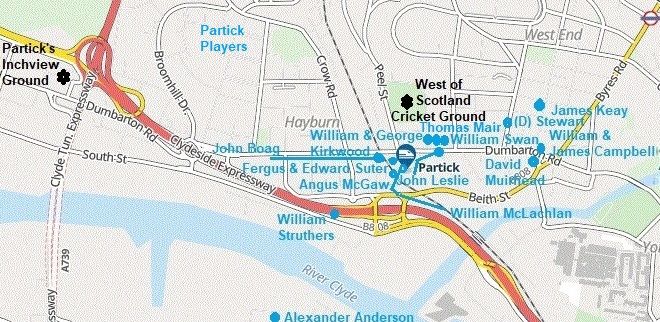The Partick Trail
The Partick Trail is different to the others we have compiled. Its main object is not to spotlight the more famous players to have come from the town, the burgh, now a Glasgow suburb, although they are listed and linked below, but the formation not of the current club that bears its name, Partick Thistle, the Jags, but the one that preceded it in early importance, not least in the emergence of professional football. That club is Partick F.C. formed in 1875, very much a local club, with its ground at Inchview at the west end of the town, where now there are the northern approaches to the Clyde Tunnel.
Of Partick the first committee and teams are both known with naturally cross-over between the two. The former consisted of William Swan, Alex Anderson, the brothers, William and James Campbell, John Paton, John Riddoch, a T. Kirkwood, David Muirhead and Thomas Mair. And of them only T. Kirkwood has proved elusive in the search for possible candidates. Of the others three factors for foundation come through. The first is location. Five alone stayed on Dumbarton Road, at Nos. 194, 204, 314 and 330, within no more than five minutes walk of each other and, coincidentally or not, within the same of the venue of the first ever football international, the West of Scotland Cricket Ground. Moreover, work connected them too. Of the nine six were clerks, commercial and legal, including John Paton, who lived on the other side of the Kelvin. And this extended into the first team. Two of the committee were there, James Campbell and Paton. Add to that two other seemingly unrelated Kirkwoods, William and George, the latter another clerk and his brother, a plumber, living on Hamilton St., two Youngs, John and David, from Bridgeton, but also both clerks, John Leslie, a draper, but staying on Dumbarton Road once more and the Englishman, William Kirkham and eight of eleven are probably traced.
And locality continued to be an important factor even in the teams that from 1876 through Kirkham were invited down to the Darwen friendlies. In that first eleven Kirkham was understandably included, as were both pairs of Campbell and Kirkwood brothers and John Young. William Swan also took his place on the left-wing and was joined by four invitees, all of whom explicable. In the case of the otherwise Rangers player, William Struthers, it was easily understandable. He had been born and stayed in Partick. And the remaining three all had strong connections with the Eastern club, playing out of Bridgeton so perhaps known or even pals of the Youngs.
And it was these same connections that seemed to continue into the eleven that also represented the Scots club against the Lancastrians in 1878. Kirkham and Struthers were still there as of the perhaps lesser lights John Boag was another who stayed on Dumbarton Rd., as would James Keay in 1881, having moved from Mansfield St.. Then Stewart was a clerk, boarding on Hyndland St., William McLachlan, a fitter on Merkland St. and Angus McGaw on Russell St. again all within a stone's throw of each other. And between them all were the Suters. Born in Ireland and Glasgow respectively Edward and Fergus were in 1871 both on Merkland Sq., both apprentices, the former to a mason and the latter a plumber. And while Fergie would after the match stay in Lancashire, returnee Edward had, by 1881 and now qualified, married and moved to Russell St., in fact to the same address, No. 10, as McGaw. Which leaves the Loves. James, who would flee bankruptcy in Glasgow to be the first to take the Darwen shilling, had by 1876 been living in Partick and seems to have been like Fergus Suter been a stone-worker. And, if the R. Love listed was related to James, he might not have been far away. By 1881 he was a Van Driver just across the water in Hutchesontown.

And the final connection was age. These, even the ones to take part in the Darwen encounters, were young men either still in or barely out of their teens. Angus McGaw was eighteen, Davie Muirhead nineteen, Jimmy Love and Fergus Suter barely twenty. They were footballing novices, which make all the more astounding the status given to some of them at least of Scotch Professor.
Partick FC was to fold in 1885. Its ground has long been built upon but not before Partick Thistle moved there for a while in the decade that followed, including election to the League. Then with promotion to the First Division for a further decade from 1897 there was Meadowside. Right by the Clyde and in Partick's town-centre it was finally a home to match the club-name. But, the requirement in 1907 for the land by its owners forced another move, this time with with final settlement in 1909 at Firhill and outwith the burgh.
For Thistle, the definite background of which can be found in The Thistle Archive, it meant that it never really became the local team that Partick had been. It also meant that top-flight, local players, with the early exception of Willie Paul, were after Partick's demise seemingly mostly picked up directly by clubs outwith. Jimmy Bowie, for example, who was born and later returned to live on Gardner St., went to Queen's Park before Rangers. And Jimmy Lawrence, born on Stewartville St. and raised on the then Hamilton St., overlooking the cricket ground, to Glasgow Perthshire in Possilpark and then, of course, to Newcastle. Nor were they alone.
The Players - Internationals
Michael Paton
Willie Watt
Willie Howden
In Scotland
Walter Hay
Stewart Calderwood
And in England and Beyond
Argentina
John Caldwell
Back to SFHGHome page